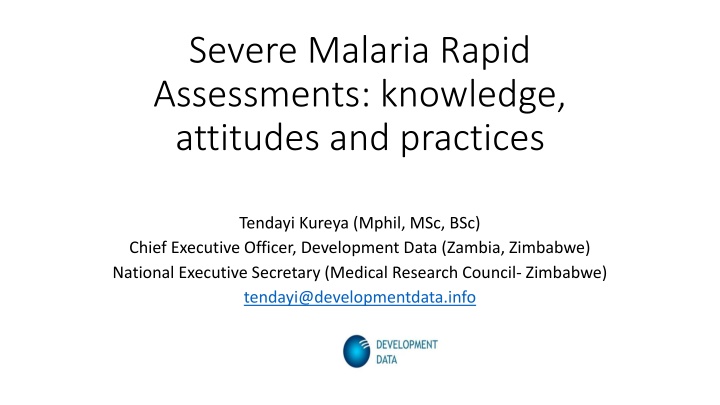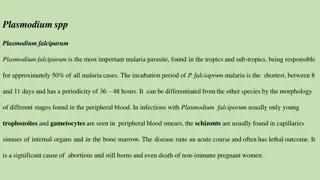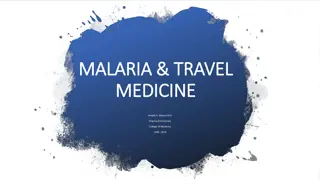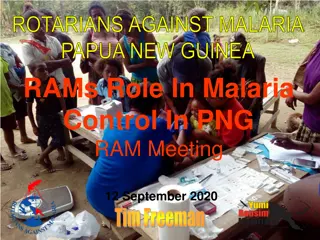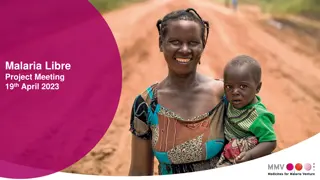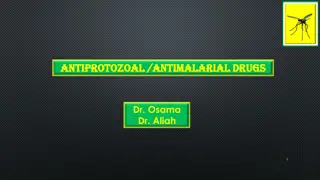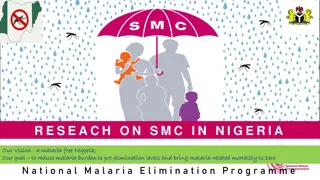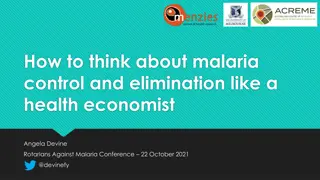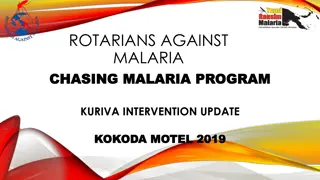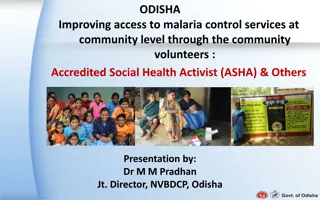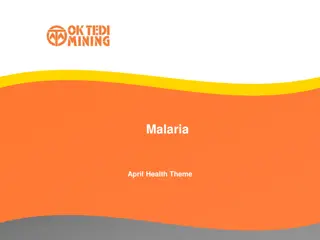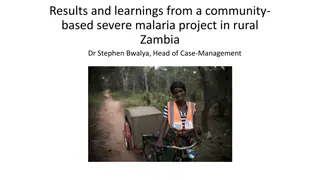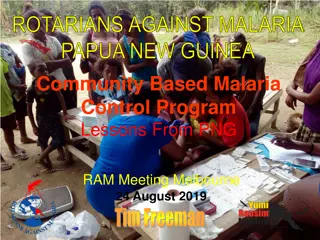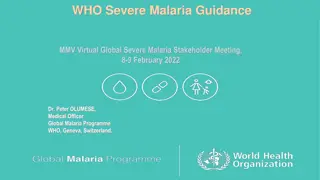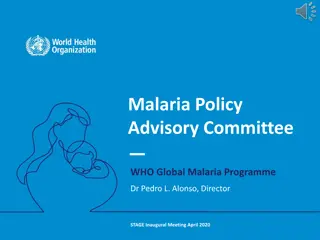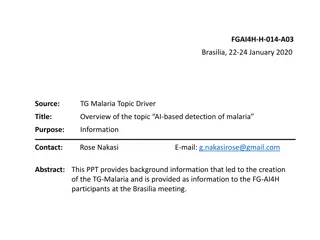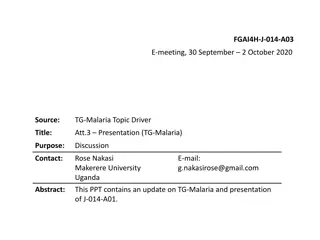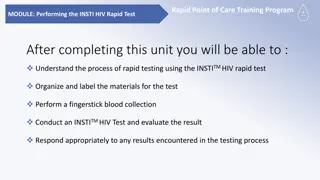Severe Malaria Rapid Assessments: Knowledge, Attitudes, and Practices
This presentation discusses severe malaria rapid assessments conducted by Development Data in Uganda and Zambia. The assessments aimed to improve severe malaria case management at community and lower health facility levels. Key findings include knowledge levels among health workers, transitioning knowledge into practice, and addressing health system issues. The assessments were implemented following WHO guidelines through a combination of methods such as facility audits, key informant interviews, focus group discussions, and feedback meetings with national-level malaria policy makers.
Download Presentation

Please find below an Image/Link to download the presentation.
The content on the website is provided AS IS for your information and personal use only. It may not be sold, licensed, or shared on other websites without obtaining consent from the author.If you encounter any issues during the download, it is possible that the publisher has removed the file from their server.
You are allowed to download the files provided on this website for personal or commercial use, subject to the condition that they are used lawfully. All files are the property of their respective owners.
The content on the website is provided AS IS for your information and personal use only. It may not be sold, licensed, or shared on other websites without obtaining consent from the author.
E N D
Presentation Transcript
Severe Malaria Rapid Assessments: knowledge, attitudes and practices Tendayi Kureya (Mphil, MSc, BSc) Chief Executive Officer, Development Data (Zambia, Zimbabwe) National Executive Secretary (Medical Research Council- Zimbabwe) tendayi@developmentdata.info
Background This presentation is based on assessments conducted by Development Data in Uganda (2017) and Zambia (2017, 2018). Results from these assessments are available on the Severe Malaria Observatory https://www.severemalaria.org/ ; In Uganda, assessments were funded by Medicines for Malaria Ventures (MMV); and conducted in partnership with the Uganda Ministry of Health- National Malaria Control Programme; and Makerere University. In Zambia, assessments were conducted as baseline and endline situations for a one-year pilot project to improve severe malaria case management. This project- Mobilising Access to Maternal Health in Zambia (MAMaZ) is a partnership between Government of Zambia- National Malaria Control Programme; MMV, TransAid, DAI Global Health; Disacare and Development Data.
Uganda and Zambia are among countries with a sizable severe malaria burden. Uganda commissioned the assessment to better understand severe malaria case management at lower levels of the health system Zambia implemented the pilot project to gather evidence for scaling up rectal artesunate as pre- referral treatment at community level.
Rapid Assessment Methods Informed by WHO guidelines for case management of severe malaria Implemented as a rapid assessment to understand current severe malaria case management practices at community level and lower level health facilities (in Busoga sub-region- Uganda; and Serenje District, Zambia) Explored issues encountered in communities and health facilities using a combination of methods: Facility audit of personnel, equipment, training and drug availability Key informant interviews with health personnel, community health volonteers, and District health officers Focus group discussions at community level Feedback meetings with national level malaria policy makers and personnel in charge of health centres
Key Findings Knowledge levels at community level Knowledge levels among health workers From knowledge to practice Health system issues
Community level Improved knowledge leads to early diagnosis, testing and treatment Support to CHVs by HWs ensures continuum of care. Community level referral system important catalyst Adequate numbers of volunteers required per community Irregular drug supplies result in bad patient health-seeking behavior; reduces trust in the system.
Case study- MAMaZ project in Zambia MMV funded a 12-month pilot project (July 2017 July 2018) in Serenje District, Zambia Focus was on severe malaria in children aged 6 months to 6 years; Baseline: 18 deaths from 224 SM cases (case fatality rate of 8%). Endline: 3 deaths from 1,215 cases of SM (case fatality rate of <0.25%) Context: Incidence of malaria dropped by 16% during the project year. Conclusion: RAS + adequately trained and equipped CHVs + health facility support = reduction in SM
Knowledge levels of severe malaria danger signs among community health workers, Serenje District, Zambia 100% 90% 80% 70% 60% 50% 40% 30% 20% 10% 0% Unconscious or Lethargic Not able to drink or eat Vomits everything Fitting Other Endline 51% 86% 91% 88% 11% Baseline 47% 29% 52% 52% 11%
Increases in reported severe malaria cases as a result of improved knowledge, Serenje District, Zambia Trends in Malaria cases 6000 180 160 5000 140 4000 120 100 3000 80 2000 60 40 1000 20 0 0 Total malaria cases in adults and children Severe malaria cases in children who are <5 years
Decline in severe malaria case fatality rates in Serenje district, Zambia 10% 9% 8% 8% 7% 6% 5% 4% 3% 2% 1% 0.25% 0% Baseline Endline
Health Facility Level Knowledge of severe malaria among health workers high HW practice influenced by available drugs and equipment HW personal preferences exist (eg Quinine over Artesunate; IM vs IV) SM equipment and drugs improve as one goes up the referral system- relies on a functional referral system Facility management training required- often overlooked. Inadequate reference materials- innovations Limited use of referral and counter-referral forms (esp from/to CHVs)
Availability of Equipment and Drugs- L3 facilities visited in Uganda Health Centre Thermom eter BP Machine Glucomet er Suction equipment Weighing scale infants IV Diazepam Rectal diazepa m IV Artesunat e Rectal Artesun ate ButagayaHC 3No Yes Yes Yes Yes Yes No No No No No No No Irongo HC 3 Yes Yes Yes Yes Yes No No No Mayuge HC 3No Yes Yes No No No No Wabulungu HC 3 Yes Yes Yes Yes Yes Yes Yes Yes Bupadengo HC 3 Yes Yes Yes Yes No No No No No Kitayundwa HC 3 Yes Yes Yes Yes No No No No No
Services provided at L3 facilities- Uganda Malaria blood smear Malaria RDT Hemoglobin Urinalysis Blood group and X- matching Blood transfusion service Blood Storage Facility Procedures Butagaya HC 3 Yes No No No No No No Irongo HC 3 Yes Yes Yes No No No No Mayuge HC 3 Yes No No No No No No Wabulungu HC 3 Yes Yes Yes Yes Yes Yes No Bupadengo HC 3 Yes Yes Yes Yes Yes No No Kitayundwa HC 3 Yes Yes Yes Yes No No No
Services provided by L4 and the RRH visited, Uganda RRH / HC IV/Procedures Malaria blood smear Malaria RDT Hemoglobin Urinalysis Blood group and X- matching Blood transfusion service Blood Storage Facility Jinja RRH Yes Yes Yes Yes Yes Yes No No No Budondo HC 4 Yes Yes Yes No No No No Kiyunga HC 4 Yes Yes Yes Yes Yes KityereraHC 4 Yes Yes Yes Yes Yes Yes Yes Kigandalo HC 4 Yes Yes Yes Yes Yes Yes Yes Namwendwa HC 4 Yes Yes Yes Yes Yes Yes Yes Nankandulo HC 4 Yes Yes Yes Yes Yes Yes No
Availability of selected severe Malaria drugs in assessed health facilities, Zambia Health Facility Quinine COARTEM Injectable artesunate Rectal Artesunate (for communities) Baseline August 2017 Kabamba RHC Kabundi RHC Kalela RHP Kashishi RHP Malcolm Moffat RHC Mulilima RHC Muzamani RHP Serenje Urban Clinic Endline May 2018 Kabamba RHC Kabundi RHC Kalela RHP Kashishi RHP Malcom Moffat RHC Mulilima RHC Muzamani RHP Serenje urban clinic
Translating knowledge to practice Mgment of SM at facility level depends on what is presented- some conditions managed at lower levels, others at higher. No uniform agreement. limited capacity limits treatment options for SM- helplessness; leads to congestion at higher levels. HW attrition in search of facilities where they can apply their knowledge 3 Delays model relevant for SM especially in children. 1stdelay responsible for underreporting of SM.
Variations in case management of severe malaria at different levels of the health system, Uganda Facility where patient can be managed (Mx) or Referred (Rx) Prognostic value Frequency Selected clinical manifestations RRH D-Hosp Level IV Level III Level II VHT +++ +++ Coma (BCS < 2) Mx Mx Rx Rx Rx Rx Impaired consciousness (BCS > 3) Mx Mx Mx Rx Rx Rx +++ +++ Respiratory distress Mx Mx Rx Rx Rx Rx +++ +++ Multiple convulsions Mx Mx Mx Mx Rx Rx +++ +++ Prostration Mx Mx Mx Rx Rx Rx +++ + Shock Mx Mx Rx Rx Rx Rx +/- +++ Pulmonary edema Mx Mx Rx Rx Rx Rx +/- +++ Abnormal bleeding Mx Mx Rx Rx Rx Rx +/- +++ Jaundice Mx Mx Mx Mx Rx Rx + ++ On scale from + to + /- indicates infrequent : RRH=Regional referral hospital; D-Hosp=District hospital Mx =complete management of patient (IV Artesunate +management of complications) Rx =Refer patient with opportunity for provision of pre-referral treatment with Rectal Artesunate
Health system issues SM case management starts at the community level and ends back there as well- requires a continuum of care Definition of severe malaria- what is treated at what level; HMIS definition and indicators for SM required Clear policies on where to place rectal artesunate Clear policies required with regards to use of traditional medicines, community pharmacies.
Conclusions 1. Improved severe malaria knowledge at community level required to reduce morbidity and mortality. 2. Support required to transform high knowledge among health workers into good SM case management practice 3. User perceptions of quality of care and of drug availability and services impacts health seeking behaviours. 4. Quality and type of referral system impacts on numbers and severity of severe malaria cases seen at higher levels of care.
Case 1: Whenever I plan on going to the facility, I think of the long waiting time at all the service points, at outpatient, laboratory and even dispensing then I change my mind. Imagine, you reach the facility at 9.00am you leave at 3.00pm - community member from a poorly served community Case 2: I called the CHV, she identified the SM danger signs, and the CHW confirmed with an RDT that it was malaria. We travelled in the night using the bicycle ambulance, and when we got to the facility, the health workers were already waiting for us - community member in a MAMaZ district Thank you
